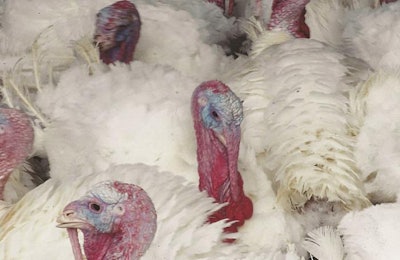
The avian influenza outbreak in 2016 was particularly hard on the turkey industry in Minnesota. Dr. Duane Murphy, veterinarian, Farbest Foods, Inc. told the audience at the Delmarva Poultry Industry’s National Meeting on Poultry Health, Processing and Live Production in Ocean City Maryland, that the industry had time to work on five things it learned from the Minnesota outbreak before the Indiana outbreak started in January 2016.
Unfortunately, he said the outbreak in 2016, which infected 9 turkey farms in Indiana, pointed out four more areas for the industry to improve upon.
Five lessons learned in the 2015 Minnesota avian flu outbreak
- Barn door biosecurity is a must – “The threat is not your neighbor, the threat is the outside world (nature)”
- Immediate depopulation (within 24 hours) is important
- Farbest had company-owned depopulation equipment
- They had a trained and prepared depopulation crew
- Indemnity-approval procedures were in place – they took pictures of the flock mortality cards with a date and time stamp
- Have a plan in place – “When the moment of crisis comes, the time for planning has passed.”
- Prepare to keep the business going while dealing with the crisis
- Get federal premise IDs for all farms
- Rehearse movement permits with the state veterinarian
- Have a surveillance crew assigned and trained
- Possibility of wind-blown infectious material
- Turn off exhaust fans on infected farms to contain the virus – done immediately
- Early marketing of nearby at-risk flocks – Done following principles of the secure supply plans – to build a fire break around infected farms
In spite of implementing procedures based on lessons learned in the Minnesota outbreak, the first flock of turkeys tested positive for avian flu on January 14, 2016. Flock records show that water consumption had dropped for the flock a couple of days before the mortality picked up. After the index case tested positive for high path avian flu, eight other farms were found to be positive for a low-path strain of avian flu that was very similar to the index virus. The outbreak was contained to these initial farms.
Murphy said that he learned four lessons from the Indiana outbreak that weren’t evident to him from his observation of the Minnesota experience.
Lessons learned from the Indiana avian flu outbreak
- Don’t rely on a single depopulation method – they were counting on using foam, but that didn’t work well at sub-freezing January temperatures. Ventilation shutdown isn’t as easy as it sounds, according to Murphy. It is difficult to implement in winter time without supplemental heaters and young birds and leaky houses make it tough to execute.
- Plan for decontamination – it can take a half day to decontaminate a depopulation crew, how many farms are you planning for one crew to depopulate in a day? Find out what is needed and how long it takes.
- If you use in-house composting to dispose of mortality, make sure you monitor the process. Murphy said one hose was closed up tight while the birds were composted ad this created serious moisture and corrosion damage to the house and equipment – you need to have some ventilation even if it is very cold outside.
- Be willing to work with government agencies - They really are there to help, but don’t expect the USDA to do everything
Murphy said that the index case in the Indiana outbreak involved a farm that was thought to have very good biosecurity and that that was somewhat deflating to all involved. He said that you have to accept that, “Not everything is under your control. So you’d better control the things that you can.”
He cautioned the industry not to get complacent since avian influenza virus is still out there. “The first step is biosecurity, know where is your line of separation,” Murphy said.


















